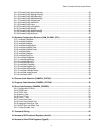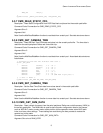SERIAL INTERFACE DEVELOPERS GUIDE
When the trigger occurs the host application can begin writing the file data to the COM port. The
bootloader receives the incoming data stream, converts the text data, and writes the executable to the
proper location in DSP program and data flash.
Once the file transfer is complete execution is transferred to the embedded application that was just
loaded.
Lumitron v0003 Bootloader Version:
The latest bootloader version no longer uses a ‘Xon/Xoff’ protocol. This is due to the implementation
of the RS-485 for specific camera configurations. Since, for this protocol we need to simulate half
duplex communications, the host computer will send a single (complete) Motorola S-Record at a time.
The data will be processed by the camera and then acknowledged with a ‘+’ character in response.
This tells the host that the camera is ready for another S-Record. Hosts that do not implement this
‘send record : wait for response’ will not function with this version of the bootloader.
Lumitron v0002/v0001 Bootloader Versions:
The upload of the embedded operational application is done using a standard “Xon/Xoff” protocol.
Where the ‘Xon’ character is hexadecimal 0x11 and the ‘Xoff’ character is hexadecimal 0x13. The
bootloader uploads files in the Motorola S-Record format.
4 Interface Protocol
The interface protocol is the set of simple binary structures and conventions, enabling data/code
exchange between a host PC and a target camera electronics controller board. It uses raw 8-bits, no
parity serial transfer at the controller board configured speed (115200 kbps by default).
The communication model is based on a master-slave basis. The PC computer sends a message
with a command plus any arguments, and the target responds immediately (within specified time) with
operation status code and return data. The target never initiates the communication. Its responses are
exactly specified and always of fixed (known) length.
4.1 PC Master Information
PC Master is a protocol that was developed by Motorola for the real time test, debugging, and
operation of DSP based hardware. It is made up of two parts: one that exists on the host and one that
exists on the DSP controller.
The module that exists on the DSP controller is part of the software development kit (SDK) that was
used in the design of the embedded camera application. Information specific to that SDK driver and
its capabilities can be obtained from Motorola (Embedded SDK: Targeting Motorola DSP56F80x
Platform SDK126/D, Embedded SDK: PC Master User Manual SDK111/D).
PC Master exists on the camera electronics as the only serial port driver for COM port 0. It operates in
a polling mode and does not initiate a transmission but only responds to them. Using fixed memory
mapped information about the DSP controller and the embedded application; it is possible to
read/write DSP peripheral registers (paragraph
X6.8X), Xilinx FPGA registers (paragraph X0X), and global
variables (paragraph
X6.2X). Using Lumitron defined commands the capability expands to allow access
to the real time clock, non-volatile RAM (paragraph TBD), serial data flash (paragraph
X6.10X), and
coefficient data flash (paragraph TBD) parts via the DSP controller. This provides the host with a
means to control/modify/check almost any configuration parameter that exists in the embedded
software.
4.2 Communications Configuration
The configuration of the serial communications has two parts. The host will need to be able to
configure which on-board port it will use and the baud rate of the port. It may also need to detect the
configured baud rate of the camera electronics. This can easily be done by cycling through the
3


















